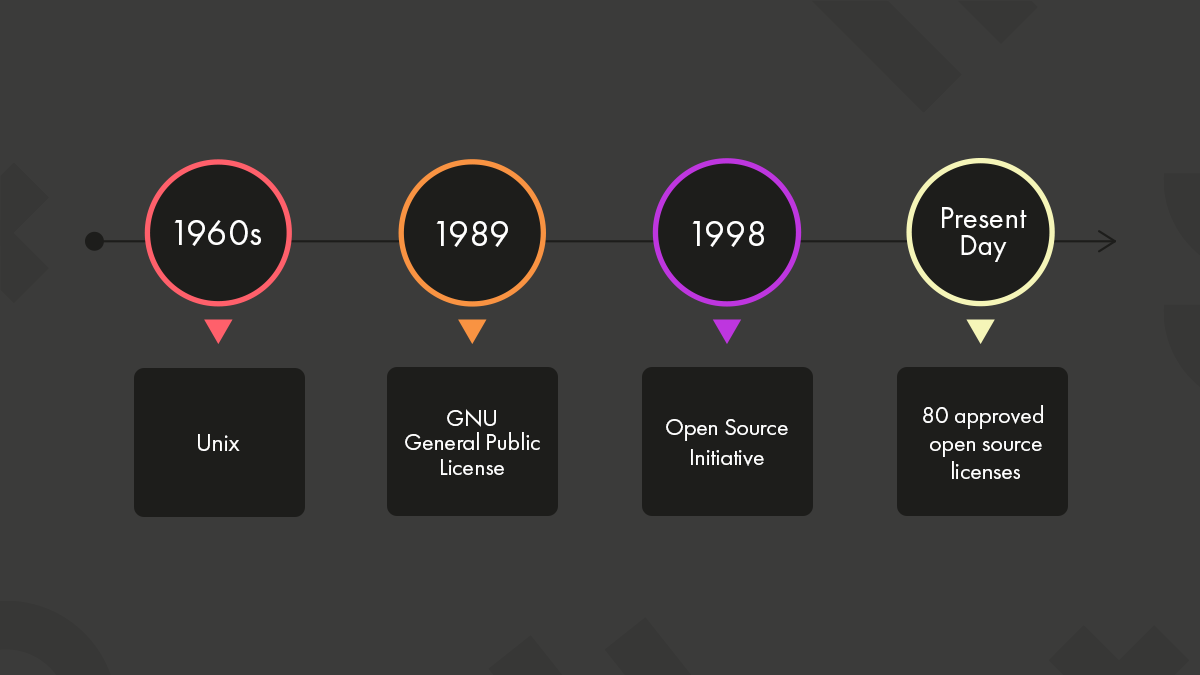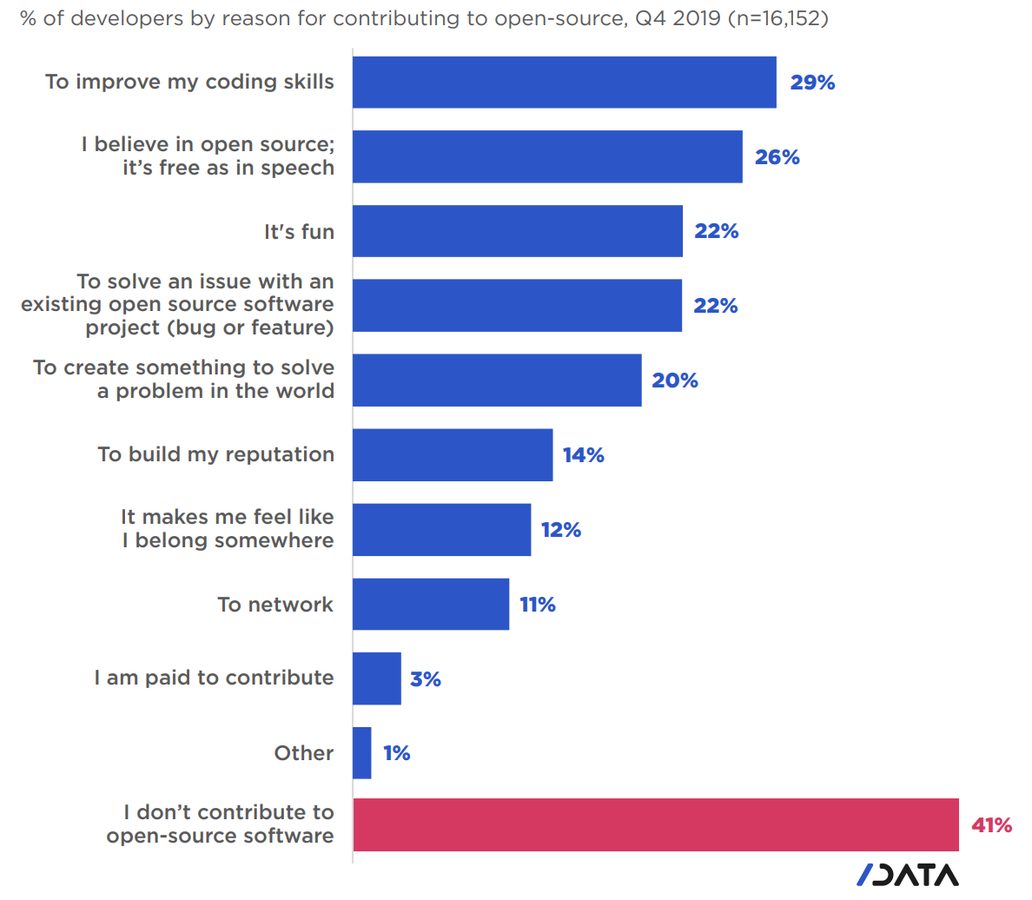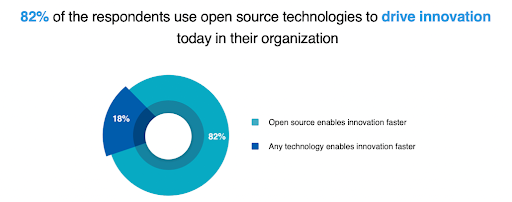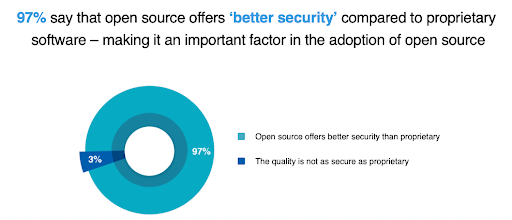What is Open-Source? (7 Reasons Why Companies prefer OSS)
Many developers are contributing consistently to open-source and sharing their ideas globally. It has reduced the time-to-market for products and improved developers’ efficiency in many ways.

Co-authored by - Aashiya Mittal

A computer science engineer with great ability and understanding of programming languages. She has been in the writing world for the last 5 years and creating valuable content for all in all possible fields. Connect with her @Aashiya Mittal
Wondering why companies prefer open-source software? Read on to learn about open-source software and the advantages of open-source for your company.
More businesses are deciding to spend money on open-source software in today's technology-driven, dynamic marketplace. Businesses might gain from open source's wide range of benefits, including shorter innovation cycles, robust community support, and vendor independence.
Many developers are contributing consistently to open-source and sharing their ideas globally. It has reduced the time-to-market for products and improved developers’ efficiency in many ways.
Suppose you prepare a special dish following a certain recipe. It becomes popular and people start asking for the recipe. You decide not to give it out and rather license it under your name. No one can know it, use it, or even modify it without your permission.
That is how proprietary software works. You and you alone would have full control over its modification and redistribution.
Now, let's say you decided to make the recipe public. People can know the ingredients and the process you used, moreover, they can add their own innovations to improve the taste of the dish.
This is an analogy describing open-source, where the source code for a program or platform is made public and other developers can revise and rework the code as they wish. They can also redistribute the modified software on their own.
Open source has laid the foundation of open innovations and proprietary standards that have changed how companies operate and collaborate today. For years, open-source has been shaping tech companies by keeping everything in equilibrium.
Perhaps you’d be amazed to know that some of the most popular software you’ve heard of such as the likes of Python, Linux, WordPress, PHP, Bittorrent, and VLC media player, among many others are all open-source.
Open-source software is used in virtually every aspect of modern technology, from smartphones to air travel, Netflix streaming to space research. Its market is expanding tremendously as a result of its widespread use, accessibility, and quick adoption in the digital transformation revolution.
According to Research and Markets, the market for open-source services would increase by over 21.6% CAGR to reach $66.8 billion by 2026.
Many companies are leveraging open-source and contributing their knowledge to make it available globally. This has resulted in a vast market where companies consistently spend on open-source mergers, ventures, apps, crypto, and acquisitions.
Undoubtedly, open source has a huge community, and its number is growing.
Let’s understand it in detail and also know how it has helped companies scale, through this article:
What is Open-Source Software?
Simply put, open-source means publicly available to everyone. It is a licensing agreement allowing developers to come forward with innovative ideas, and anyone can use it for free.
Open-source focuses on the freedom to think and collaborate with the open-source community. This has led to open-source software, platforms, tools, and services.
Its philosophy is based on the five pillars of transparency, collaboration, delivery, inclusion, and community.
The increased exchange of ideas and code developed by communities or individual developers has resulted in more creative, scientific, innovative, and technological advancements across different segments.
How does Open-Source work?
Open-source software is generally kept in a public repository and can be accessed by anyone who is welcome to use the code independently or add enhancements to the project's overall functionality and design.
OSS includes a distribution license. This license stipulates the conditions under which programmers may use, examine, alter, and—most significantly—distribute the software.
The five most popular licenses, according to the Synopsys Black Duck® KnowledgeBase, are:
- MIT License
- GNU General Public License (GPL) 2.0
- Apache License 2.0
- GNU General Public License (GPL) 3.0
- BSD License 2.0 (3-clause, New or Revised)
OSS must document the changes along with the procedures used when the source code is modified. The software that results from these modifications may or may not be freely available, depending on the license conditions.
With technological advancement, large enterprises are adopting open-source programs to quickly and affordably achieve their goals.
What led us to Open-Source, leaving behind Proprietary software?
The below chart depicts the overall picture of how open-source entered and evolved-

Let’s also understand the development and evolution of OSS through this detailed infographic:
Now that we’ve understood to some extent how exactly open source evolved and the different phases and changes it has gone through over the years, let’s delve deeper into the ‘Why’. Why have more and more companies adopted it leading to its meteoric rise?
Why do companies prefer Open-Source?
Today companies are going for open-source programs, bringing a swift change in the software market, and leaving behind proprietary software. Without a doubt, you will see an increase in this trend.
Whether a small or large enterprise, you will see changes once you opt for open source, especially in app development. Several benefits are driving this change in the market. Let's look at a few advantages of OSS for companies:
Solves Vendor Lock-in Problems
When companies use proprietary software, platforms, or databases, they find it difficult to transition to other alternative vendors without suffering business disruption and added expenses. This situation is commonly known as vendor lock-in. Emerging organizations are especially prone to vendor lock-in, as the eccentric solutions that made sense in the initial stages no longer work as their business grows.
Eliminating the expensive proprietary software and replacing them with open source solves vendor lock-in problems. It provides massive freedom to use, edit, and distribute it per individual requirements. Now companies do not have to worry about increased or revised software pricing, compatibility issues, updates, etc.
Avoiding vendor lock-in opens new opportunities to excel and innovate.
Attracts talented contributors
Open source has attracted more talent globally, opening more opportunities for developers to learn and improve their skills. Organizations are focusing on such talent. Developers, in turn, get the freedom to code and test and find the scope of being innovative and creative.
"Facebook sees open source as being good for business: “It means we build better software, write better code, our engineers are able to work with more pride, and we’re able to retain the world’s best engineers because they know they can open-source their work.” Ultimately, because engineers can see for themselves the kinds of things Facebook is working on, it makes it easier to attract top talent. “It’s not all altruism, there’s solid business sense behind this.” ~ James Pearce, Facebook, Venture Beat
And he can’t be wrong. Adopting OSS helps organizations in multiple ways:
- It helps build more employable skills in their staff
- It increases the available resources for problem-solving
- Promotes a collaborative, open-minded culture in companies
No wonder, 70% of the tech talent prefers OSS to proprietary cloud technologies, according to an IBM study.
Thus, it’s quite clear that without adopting open-source technologies, it will be harder for software companies to draw top-tier talent.

Builds a Strong Community
One of the most important benefits of open-source software is its community-oriented culture. As they are built on cooperation, communication, and the idea that there is no "winner," open-source communities are really effective. Everyone is a part of the same team and is working toward the same goal.
Building a tailored solution based on pre-existing code is quite straightforward, and the greatest thing is that you can contribute back to the project by making the new solution itself open-source and accessible to the general public. It allows for fostering a strong and connected community.
And such robust communities enable quicker, more reliable release cycles.
Case in point: The Facebook-backed React, which was introduced in 2013, is already on version 17. In contrast, Vue, a similarly well-liked technology introduced around the same time but with a smaller supporting community, is currently on major version 3.
Drives Innovation.
Open source has been a crucial factor in driving modern-age technology and improving the level of innovation. With open source, every software, service, and tool is readily available that you can use to get started anytime.

As ideas spread faster, the speed of innovation also shoots up. This, in turn, permits quicker responses and adaptations to the current trends and market needs.
It’s a highly important advantage for companies given how the fast paced-change presents a danger of falling behind if they don’t innovate fast enough. Also, considering how the companies are frequently at loggerheads with each other when it comes to new technologies and innovation.
Today’s technology like containers, microservices, serverless, Kubernetes, docker, and others are leveraging open-source software.
Higher Quality Software
It’s simple mathematics, isn’t it? A piece of software generated by a team of programmers may not be as high-quality as the software created by thousands of programmers from across the world who have expertise in a variety of technologies, fields, and projects.
Even the open-source code written by a single developer can be of higher quality than proprietary code, as the code will simultaneously be viewed by thousands of techies and no one wants to look like a code monkey in front of such a crowd. It’s a different case, however when you’re writing code that only your colleagues can see. You might get a bit flaky.
Also, with thousands of eyeballs reviewing the open-source software, bugs can be identified pretty easily.
Way back in 2013, Coverity, a company specializing in software quality and security testing solutions, verified this point by stating that open-source programs tend to have fewer errors per thousand lines of code than their proprietary software brothers. Here’s the report:
Therefore, it's no wonder that most organizations deem software quality to be the top reason for choosing to work with open-source software.
Cost-effectiveness
Open-source software is appealing to many businesses since there are no upfront expenses involved in downloading the code and using it. Additionally, because a portion of the development and maintenance burden is shared with a community outside the corporation, total costs for product development are cheaper.
When additional costs for maintenance and software upgrades are involved, proprietary software is not something you should spend a fortune on. Contributors make all necessary modifications to open-source software. The inputs from several different experts help it work successfully in real time.
More superior software
Open-source development enables companies to access a worldwide talent pool. An open-source project allows developers from all around the world to participate, guaranteeing the usage of the finest concepts and procedures.
Additionally, open-source development encourages greater developer cooperation. Together, engineers may exchange expertise and ideas to produce better code. Bugs are also readily discovered and repaired because the code is open for anybody to review and enhance.
Businesses may obtain the greatest software available without paying the high development expenses associated with commercial suppliers by employing open-source technologies.
Agility and Flexibility
Speed and agility are essential in the business IT sector. The ability of an organization to quickly adapt to changing market conditions and customer demands can mean the difference between success and failure. For that very reason, for many businesses, open-source development is the best option available.
Businesses can adapt open-source software to meet their own requirements. They may quickly extend their infrastructure as their business expands since they are not restricted to a single vendor or platform. Without having to wait for the software provider to make modifications, they may also add or remove functionality as required. This makes it possible for firms to operate considerably more swiftly and adapt to changes in the market or their sector.
Improves Security
While you may think that due to the vastly open nature of a project’s code, it seems more vulnerable to security threats, it’s actually quite the opposite.
Since vulnerabilities and security gaps are made more and more accessible along with the source code, open-source software's transparency actually benefits it.
Any potential bugs are detected and fixed at a fast pace with the help of a huge community of pooled resources and developers.
Broken code in closed-source software can only be fixed by the vendor, which could take more time, but with open-source software, DevOps teams can independently confirm the security of the source codes.
Also in most cases, open-source software projects have access to tools that enable a DevSecOps approach to mitigate flaws in a code base.
For example, GitHub’s supply chain security tools use vulnerability databases and automate the process of patching vulnerabilities.
More and more innovations have taken place to improve data security in open-source software, it’s an ongoing process.
Such reasons contribute to the popularity of open source.

Open-Source is Cost-efficient
OSS can significantly lower the development costs when compared to commercially-licensed software or even in-house developed software.
These financial savings begin with procurement and continue with deployment, support, and maintenance.
Here are a few reasons why:
- It prevents bundling and excessive functionality
- Eliminates clumsy closed system deployments
- Avoids vendor lock-in, as discussed earlier
- Avoids consultation pitfalls associated with proprietary systems by helping with consulting and support costs
- Benefits from continued community support which is generally free
Whether small or large, every company wants to reduce expenses, and open source has made it more accessible. As open source reduces the time-to-market, the cost of developing any software or app is also reduced.
So, these were the 7 most important reasons why open source software has gained immense popularity in the market today. But it does have its own fair share of challenges.
Challenges ahead for Open-Source
Despite solving real-world challenges, there are some challenges ahead for open source.
Let’s quickly go through the challenges and discuss alternate ways to avoid them while implementing open-source programs within the organization:
Complex UI and settings.
Some open-source software has complex settings and interfaces. It might end up with compatibility issues while setting up the software remotely.
Solution: Testing can help you fix those complex settings. Take a senior’s help in learning how it works and involve yourself in the required training.
Lack of open-source skill set
Some companies face challenges due to the lack of employees with open-source skill sets. They will not be able to work with the complex UI of the open source and understand where to start.
Solution- You can conduct training by market professionals who can help you learn the skills. It is better if the company enrolls its best employees for them to be productive.
Scaling of open-source projects.
While choosing open source, consider other factors rather than low cost. Your business might face challenges related to deployment, costs, security, and licenses.
Solution: Run your program under lab conditions, and then run a pilot program to check if your project can quickly scale without impacting the overall performance.
Wrap up
Looking at the overall picture, open source has changed the outlook of the tech industry and opened doors to a new innovative world. It lets developers test their creativity and develop next-generation technologies. With open-source, there is no limit to technological advancement and how it can help people to create new applications, providing a better user experience.
Many developers are contributing consistently to open-source and sharing their ideas globally. It has reduced the time-to-market for products and improved developers’ efficiency in many ways.
Enterprise software development now mostly consists of open-source work, which is the driving force behind ongoing innovation across on-premise, at the edge, in public clouds, and beyond.
With this idea of collaboration and sharing, coming up with innovation has become more accessible, which opens doors for businesses to partner with others and leverage partnerships.
Open source has a growing future and is growing faster than any other market. It means we can experience more advancement in the coming decade.
FAQs
Why is open source better than commercial software?
Most open-source software has no restrictions in terms of usage, modification, and distribution. All users have access to the source code of open-source software, allowing them to alter and adapt it to meet their needs.
Is open-source better for privacy?
There is a perception that releasing source code for public inspection would reduce the number of problems. In the same manner, it is thought that closed-source software, like Microsoft Windows, limits the number of individuals who can audit, find, and fix problems.

